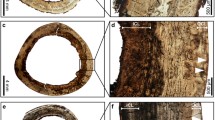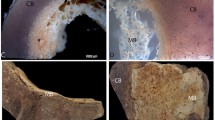Abstract
Female birds produce medullary bone to offset heightened calcium demand during egg shelling. The ephemeral nature of medullary bone hampers its observation in wild birds; thus, its phylogenetic distribution and ecophysiological correlates remain controversial. To address this, I candled a phylogenetically broad sample of bird skeletons spanning a large range of body sizes. I hypothesized that the presence of medullary bone would reduce or eliminate light penetrance through long bones. Candling suggested medullary bone was present in many adult female specimens, which was confirmed visually or with digital X-rays. This survey yielded the first unambiguous evidence of medullary bone in several taxa, including hummingbirds, tinamous, megapodes, and kiwi. The phylogenetic distribution of these new occurrences confirms that medullary bone is phylogenetically widespread among birds, including palaeognaths and passerines. The rapid assessment of complete skeletons supports a relationship between medullary bone and hematopoietic marrow, and establishes that the skeletal distribution of medullary bone varies taxonomically. Because the presence of medullary bone confirms sex, maturity, and reproductive status, its detection in specimens of known collection date can improve our understanding of life history and reproductive timing in wild birds, even decades later.
Zusammenfassung
Medullärer Knochen ist stammesgeschichtlich weit verbreitet, aber wo im Skelett er auftritt, variiert zwischen Taxa
Vogelweibchen produzieren medullären Knochen, um ihren erhöhten Kalziumbedarf während der Produktion von Eierschalen zu stillen. Die temporäre Natur dieses Knochengewebes erschwert seinen Nachweis in Wildvögeln, weshalb seine stammesgeschichtliche Verbreitung und ökophysiologischen Korrelate nach wie vor umstritten sind. Daher habe ich eine stammesgeschichtlich breite Stichprobe von Vogelskeletten unterschiedlicher Körpergröße durchleuchtet. Ich habe die Hypothese aufgestellt, dass das Vorhandensein medullären Knochens die Lichtdurchdringung von Röhrenknochen verringern oder ganz verhindern sollte. Das Durchleuchten deutete darauf hin, dass medullärer Knochen bei vielen Exemplaren adulter Weibchen vorhanden war, was dann visuell oder mit Hilfe digitaler Röntgenbilder bestätigt wurde. Diese Untersuchung lieferte den ersten eindeutigen Beleg für das Vorhandensein medullären Knochens in mehreren Taxa, einschließlich Kolibris, Steißhühnern, Großfußhühnern und Kiwis. Die stammesgeschichtliche Verbreitung dieser neuen Nachweise bestätigt, dass medullärer Knochen bei Vögeln stammesgeschichtlich weit verbreitet ist und bei Urkiefer- und Sperlingsvögeln vorkommt. Eine schnelle Prüfung vollständiger Skelette stützt einen Zusammenhang zwischen medullärem Knochen und blutbildendem Knochenmark und zeigt, dass die Verteilung medullären Knochens im Skelett zwischen Taxa variiert. Da das Vorkommen medullären Knochens Geschlecht, Geschlechtsreife und Fortpflanzungsstatus bestätigt, kann sein Nachweis in datierten Sammlungsexemplaren selbst mehrere Jahrzehnte später zu einem besseren Verständnis der Lebensgeschichte und des Fortpflanzungstimings von Wildvögeln führen.



Similar content being viewed by others
References
Adam MD, des Lauriers JR (1998) Observations of hummingbirds ingesting mineral-rich compounds. J Field Ornithol 69:257–261. http://www.jstor.org/stable/4514314
Ankney CD, Scott DM (1980) Changes in nutrient reserves and diet of breeding Brown-headed Cowbirds. Auk 97:684–696. http://www.jstor.org/stable/4085740
Best J, Mulville J (2014) A bird in the hand: data collation and novel analysis of avian remains from South Uist, Outer Hebrides. Int J Osteoarchaeol 24:384–396. https://doi.org/10.1002/oa.2381
Bloom W, Bloom MA, McLean FC (1941) Calcification and ossification. Medullary bone changes in the reproductive cycle of female pigeons. Anat Rec 81:443–475. https://doi.org/10.1002/ar.1090810404
Bloom MA, Domm LV, Nalbandov AV, Bloom W (1958) Medullary bone of laying chickens. Am J Anat 102:411–453. https://doi.org/10.1002/aja.1001020304
Bonucci E, Gherardi G (1975) Histochemical and electron microscope investigations on medullary bone. Cell Tissue Res 163:81–97. https://doi.org/10.1007/BF00218592
Bowman BM, Miller SC (1986) The proliferation and differentiation of the bone-lining cell in estrogen-induced osteogenesis. Bone 7:351–357. https://doi.org/10.1016/8756-3282(86)90255-3
Currey JD, Alexander RM (1985) The thickness of the walls of tubular bones. J Zool Lond A 206:453–468
Dacke CG, Arkle S, Cook DJ, Wormstone IM, Jones S, Zaidi M, Bascal ZA (1993) Medullary bone and avian calcium regulation. J Exp Biol 184:63–88
Dacke CG, Sugiyama T, Gay CV (2015) The role of hormones in the regulation of bone turnover and eggshell calcification. In: Scanes CG (ed) Sturkie’s avian physiology, 6th edn. Academic Press, San Diego, pp 549–575. https://doi.org/10.1016/B978-0-12-407160-5.00025-7
Delany ME, Tell LA, Millam JR, Preisler DM (1999) Photographic candling analysis of the embryonic development of Orange-winged Amazon Parrots (Amazona amazonica). J Avian Med Surg 13:116–123. http://www.jstor.org/stable/30135215
des Lauriers JR (1994) Hummingbirds eating ashes. Auk 111:755–756. http://www.jstor.org/stable/4088486
Eda M, Yashima S, Kusuhara S, Inoué T (2010) Histological analysis of medullary bones from archaeological sites in Japan. In: Prummel W, Zeiler JT, Brinkhuizen DC (eds) Birds in archaeology: proceedings of the 6th meeting of the ICAZ Bird Working Group in Groningen (23 Aug to 27 Aug 2008), Barkhuis, Groningen, pp 255–259
Eeva T, Ojanen M, Räsänen O, Lehikoinen E (2000) Empty nests in the Great Tit (Parus major) and the Pied Flycatcher (Ficedula hypoleuca) in a polluted area. Environ Pollut 109:303–309. https://doi.org/10.1016/S0269-7491(99)00256-0
Estades CF, Vukasovic MA, Tomasevix JA (2008) Giant hummingbirds (Patagona gigas) ingest calcium-rich minerals. Wilson J Ornithol 120:651–653. https://doi.org/10.1676/07-054.1
Fleming RH, McCormack HA, McTeir L, Whitehead CC (1998a) Medullary bone and humeral breaking strength in laying hens. Res Vet Sci 64:63–67. https://doi.org/10.1016/S0034-5288(98)90117-5
Fleming RH, McCormack HA, Whitehead CC (1998b) Bone structure and strength at different ages in laying hens and effects of dietary particulate limestone, vitamin K and ascorbic acid. Br Poult Sci 39:434–440. https://doi.org/10.1080/00071669889024
Gutzwiller SC (2010) Postcranial skeletal pneumaticity, bone structure, and foraging style in two clades of neognath birds. Unpublished BS Thesis, Ohio University. https://etd.ohiolink.edu/rws_etd/document/get/ouhonors1275601248/inline Accessed 24 Aug 2016
Harcourt-Brown N (2004) Development of the skeleton and feathers of dusky parrots (Pionus fuscus) in relation to their behavior. Vet Rec 154:42–48. https://doi.org/10.1136/vr.154.2.42
Houston DC (1978) The effect of food quality on breeding strategy in Griffon vultures (Gyps spp.). J Zool Lond 186:175–184
Kenny AD (1986) Parathyroid and ultimobranchial glands. In: Sturkie PD (ed) Avian physiology. Springer, New York, pp 466–478
Krementz DG, Ankney CD (1995) Changes in total body calcium and diet of breeding House Sparrows. J Avian Biol 26:162–167. https://doi.org/10.2307/3677065
Kyes P, Potter TS (1934) Physiological marrow ossification in female pigeons. Anat Rec 60:377–379. https://doi.org/10.1002/ar.1090600402
Landauer W, Pfeiffer CA, Gardner WU, Shaw JC (1941) Blood serum and skeletal changes in two breeds of ducks receiving estrogens. Endocrinol 28:458–464. https://doi.org/10.1210/endo-28-3-458
Lokemon JT, Koford RR (1996) Using candlers to determine the incubation stage of passerine eggs. J Field Ornithol 67:660–668. http://www.jstor.org/stable/4514170
MacLean SF (1974) Lemming bones as a source of calcium for arctic sandpipers (Calidris spp.). Ibis 116:552–557. https://doi.org/10.1111/j.1474-919X.1974.tb07653.x
March GL, Sadleir RMFS (1975) Studies on the Band-Tailed Pigeon (Columba fasciata) in British Columbia. III. Seasonal changes in body weight and calcium distribution. Physiol Zool 48:49–56. http://www.jstor.org/stable/30155637
Matthiesen DG (1988) Preceramic animal use on the central coast. In: Wing ES, Wheeler JC (eds) Economic prehistory of the Central Andes (B.A.R. International Series 427). BAR Publishing, Oxford, pp 18–30
Mayr G (2016) Fragmentary but distinctive: three new avian species from the early Eocene of Messel, with the earliest record of medullary bone in a Cenozoic bird. Neues Jahrb Geol P-A 279:273–286. https://doi.org/10.1127/njgpa/2016/0555
Pahl R, Winkler DW, Graveland J, Batterman BW (1997) Songbirds do not create long-term stores of calcium in their legs prior to laying: results from high-resolution radiography. Proc R Soc Lond B 264:239–244. https://doi.org/10.1098/rspb.1997.0034
Pattee OH, Wiemeyer SN, Swineford SM (1988) Effects of dietary fluoride on reproduction in Eastern Screech-owls. Arch Environ Contam Toxicol 17:213–218. https://doi.org/10.1007/BF01056027
Piersma T, Gudmundsson GA, Davidson NC, Morrison RIG (1996) Do Arctic-breeding Red Knots (Calidris canutus) accumulate skeletal calcium before egg laying? Can J Zool 74:2257–2261. https://doi.org/10.1139/z99-255
Prum RO, Berv JS, Dornburg A, Field DJ, Townsend JP, Lemmon EM, Lemmon AR (2015) A comprehensive phylogeny of birds (Aves) using targeted next-generation DNA sequencing. Nature 526:569–573. https://doi.org/10.1038/nature15697
Reynolds SJ (1997) Uptake of ingested calcium during egg production in the Zebra Finch (Taeniopygia guttata). Auk 114:562–569. http://www.jstor.org/stable/4089275
Rick AM (1975) Bird medullary bone: a seasonal dating technique for faunal analysis. Bull Can Archaeol Assoc 7:183–190. http://www.jstor.org/stable/41242403
Ringoen AR (1945) Deposition of medullary bone in the female English Sparrow, Passer domesticus (Linnaeus), and the Bobwhite Quail, Colinus virginianus. J Morphol 77:265–283. https://doi.org/10.1002/jmor.1050770208
Schweitzer MH, Wittmeyer JL, Horner JR (2005) Gender-specific reproductive tissue in ratites and Tyrannosaurus rex. Science 308:1456–1460. https://doi.org/10.1126/science.1112158
Schweitzer MH, Zheng W, Zanno L, Werning S, Sugiyama T (2016) Chemistry supports the identification of gender-specific reproductive tissue in Tyrannosaurus rex. Sci Rep 6:23009. https://doi.org/10.1038/srep23099
Simkiss K (1961) Calcium metabolism and avian reproduction. Biol Rev 36:321–367. https://doi.org/10.1111/j.1469-185X.1961.tb01292.x
Simkiss K (1967) Calcium in reproductive physiology. Chapman & Hall Ltd, London
Smith ND (2012) Body mass and foraging ecology predict evolutionary patterns of skeletal pneumaticity in the diverse “waterbird” clade. Evolution 66:1059–1078. https://doi.org/10.1111/j.1558-5646.2011.01494.x
Smith NA, Clarke JA (2014) Osteological histology of the Pan-Alcidae (Aves, Charadriiformes): correlates of wing-propelled diving and flightlessness. Anat Rec 297:188–199. https://doi.org/10.1002/ar.22841
Squire ME, Brague JC, Smith RJ, Owen JC (2011) Evidence of medullary bone in two species of thrushes. Wilson J Ornithol 123:831–835. https://doi.org/10.1676/11-014.1
Sugiyama T, Kusuhara S (2001) Avian calcium metabolism and bone function. Asian Australas J Anim Sci 14:82–90
Taylor TG, Moore JH (1953) Avian medullary bone. Nature 172:504–505. https://doi.org/10.1038/172504a0
Taylor TG, Simkiss K, Stringer DA (1971) The skeleton: Its structure and metabolism. In: Bell DJ, Freeman MB (eds) Physiology and biochemistry of the domestic fowl. Academic Press, New York, pp 621–690
Van de Velde JP, Vermeiden JPW, Hagen BJ, Van Ginkel FC, Prahl-Andersen B (1985) Histological and radiological quantification of estradiol-induced medullary bone formation and osteoclast activity in male quail. Bone 6:391–393. https://doi.org/10.1016/8756-3282(85)90338-2
Westerskov K (1950) Methods for determining the age of game bird eggs. J Wildl Manag 14:56–67. https://doi.org/10.2307/3795978
Whitehead CC (2004) Overview of bone biology in the egg-laying hen. Poult Sci 83:193–199. https://doi.org/10.1093/ps/83.2.193
Yamamoto T, Nakamura H, Tsuji T, Hirata A (2001) Ultracytochemical study of medullary bone calcification in estrogen injected male Japanese quail. Anat Rec 264:25–31. https://doi.org/10.1002/ar.1101
Acknowledgements
I thank Helen James and Christopher Milensky for access to USNM Bird Specimens, Sandra Raredon for access to and training on the USNM digital X-ray, and Matthew Brown and Chris Sagebiel for access to TMM specimens. Mary Schweitzer and Kevin Padian provided valuable discussion about the appearance and distribution of medullary bone. I thank Franz Bairlein, Daniel Field, and two anonymous reviews and for constructive comments that improved this manuscript. This work complies with the current laws of the country in which they were performed.
Author information
Authors and Affiliations
Corresponding author
Ethics declarations
Conflict of interest
The author declares that she has no conflicts of interest.
Additional information
Communicated by F. Bairlein.
Electronic supplementary material
Below is the link to the electronic supplementary material.
10336_2017_1514_MOESM1_ESM.pdf
An expanded discussion of methods and results, additional references for Fig. 3, and X-ray images for all 22 X-rayed specimens listed in Tables 1 and S1 (PDF 23971 kb)
10336_2017_1514_MOESM2_ESM.xlsx
Full dataset of specimens examined (includes additional notes, reproductive data, and natural history data) (XLSX 32 kb)
Video illustrating the candling method, using USNM 560556 (female Phalacrocorax auritus). Video is also available at https://youtu.be/XHkBk7JhKaA (MOV 251974 kb)
Rights and permissions
About this article
Cite this article
Werning, S. Medullary bone is phylogenetically widespread and its skeletal distribution varies by taxon. J Ornithol 159, 527–543 (2018). https://doi.org/10.1007/s10336-017-1514-z
Received:
Revised:
Accepted:
Published:
Issue Date:
DOI: https://doi.org/10.1007/s10336-017-1514-z




